How to make a dollhouse needlepoint cushion
ONLINE MINIATURE NEEDLEPOINT EMBROIDERY TUTORIALS
These tutorials were originally written to help people who had bought my dollhouse needlepoint kits – they show you how to do the stitching and assemble each type of kit. In November 2024 I retired, so these pages are now a ‘legacy archive’ only. I NO LONGER SELL THESE KITS, so please do not contact me asking where you can buy them! I plan to keep these tutorials available until at least the end of 2026, so that people who bought kits but haven’t made them up yet have a while to use the tutorials to complete their kits 🙂
These cushions are really cute, and are simple enough for a complete beginner to successfully complete one in just a few hours! Each cushion measures 1¼ x 1¼ inches (3.25 x 3.25 cm).
These miniature dollshouse cushion kits are designed to be worked with two strands of Anchor stranded cotton (the kit packs contain plenty of thread of each colour needed). A piece of 22 count canvas, backing fabric and wadding are included, along with a tapestry needle and detailed instructions (including how to do tent stitch, which is similar to half cross stitch).
Finished in a few hours, they make handy presents!
If you have never done miniature needlepoint before, start by reading the BASIC EQUIPMENT and NEEDLEPOINT STITCHES tutorials first, then come back to this page.

Identify the thread colours supplied in the kit using the colour key, then, using tent stitch and two strands of the Anchor stranded cotton, start the design in the centre. As these kits are quick to do, and the canvas is quite sturdy, you do not need to use any kind of frame when stitching them. Remember that one square on the chart equals one stitch, and always use a ‘stabbing’ motion, not a ‘sewing’ (scooping) one.
When the stitching is complete, if it has become slightly mis-shapen, press it on the reverse side with a medium hot iron, on a padded ironing board, pulling the fabric gently if necessary to get it dead square.
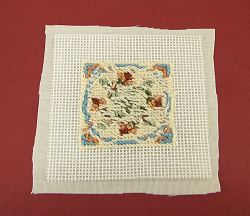
Trim the spare canvas around the stitching to half an inch all round. Place the stitching and the backing fabric right sides together.
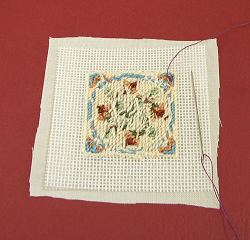
Thread a sewing needle with about two feet of strong sewing cotton in a similar shade to the background colour of the cushion. NB: For clarity, I have used a contrasting thread shade in the photos.
Starting at a corner of what will be the bottom edge of the cushion when finished (if the design has an ‘up’ and a ‘down’ – some do, some don’t), secure the sewing cotton firmly by backstitching through the reverse of some of the tent stitches already worked (being careful that your backstitches don’t go through and show on the front).
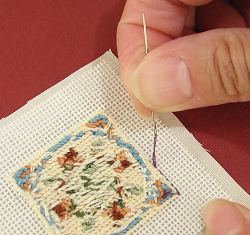
Then pass the needle right to the corner of the stitched area, and begin backstitching through the outermost row of holes that you previously used for the tent stitches of the design. Make one stitch into every hole, so that the row of stitches is strong.
When you reach a corner, work one or two stitches before and after the corner twice into the same holes, for extra strength.

It is important that you bring the needle out BETWEEN the two layers as you finish the final backstitch on the third side, so that the thread will be on the outside of the cushion once it is turned right side out. LEAVE THE LENGTH OF THREAD ATTACHED while you do this next stage.
When you have completed all three sides of backstitching, carefully trim the canvas and fabric backing neatly to barely a quarter of an inch along the three sides that you have stitched. Widen the seam allowances at the ends a little where they meet the seam allowance of the open side (see picture). Along the final open side, trim the canvas and fabric to about three eighths of an inch. Trim across the two bottom corners to lessen bulk, as shown in the picture.
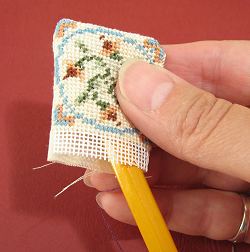
Turn the cushion right side out. Rub the seams between your finger and thumb to get the seam to settle flat. To get the corners turned properly, it may be necessary to push a blunt pencil carefully into the corners.
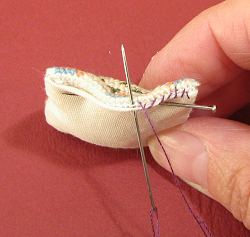
Using the wadding included in the kit, pull off small pieces and stuff the cushion. Do not overstuff! Turn in the canvas and fabric seam allowances (one dressmaker’s pin to temporarily hold them together may be useful here). Pick up the sewing thread length again, and with tiny oversewing stitches, close the final side of your cushion.
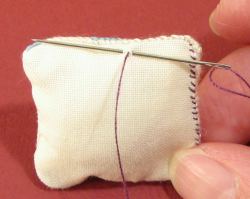
To finish off the length of thread, bring the needle out about half an inch away from the seam you have just stitched, along the edge of the fabric side of the cushion, and make two tiny backstitches close together, then cut the thread as close as you can to the fabric.

Your cushion is now finished, and ready to grace your dollshouse.


